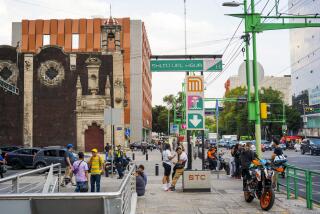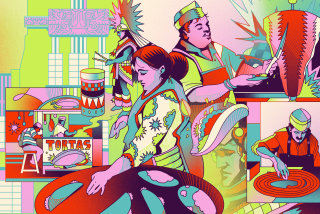Mexican Money: What’s the Grade North of the Border?
- Share via
Question: Today, there is an active market for United States uncirculated coins graded MS-63, MS-64 and MS-65. I would like to know if there is such a market for Mexican coins as well. If not, do you see one developing in the future?--R.K.
Answer: Mexican coins have long been popular with U.S. collectors. In part this is due to the proximity of Mexico. In part it has to do with the normal collecting urge. There are collectors for every country imaginable, but Mexico and Canada rank high with Americans because of common interests, shared histories and virtually open borders.
During Spanish rule, Mexican coinage circulated freely in the United States, and many consider pieces of eight (some minted in Mexico) among our earliest coins. There is an active market for such coins and others during the colonial period of Mexico. Modern issues also have a strong following.
Just as you’ll find dealers who specialize in ancient coinage or world coins, so too you will find some who are experts in Mexico or South America. But there are differences insofar as grading is concerned.
United States coins are now virtually universally graded on a scale of 1 to 70 with coins in the 60-to-70 range considered to be uncirculated. The higher the grade the better and more expensive the coin. Some grading services and dealers will vouch for the quality of a coin. But even so, there is often disagreement between grading services and dealers as to the accuracy of a given grade. And beyond this, two similar coins given the same grade may still vary in price due to the greater eye appeal.
So far, no such grading services exist for foreign coins, although some dealers will personally grade them and some grading services have flirted with the idea of grading them.
My suggestion regarding Mexican coins would be to purchase the best quality available, keeping in mind that no universal grading standards actually exist. Experience is still the best teacher. Grading is an art, not a science.
Q: About 20 years ago while selling Girl Scout cookies a customer mentioned saving bills with Joseph Barr’s signature. He said they would be valuable because of the short term he held office under President Kennedy. I’ve never seen or heard anything about this. What determines the value?--K.K.
A: Many people are under the impression that bills with Barr’s signature are valuable. This is a fallacy. It’s true that he was Treasurer for a short period of time, but the government made sure that millions and millions of bills bearing his signature were run off in order to prevent hoarding and speculation. Whatever bills you might have are just worth face value.
Q: One of my hobbies is collecting coins. One of the oldest I have is marked 1893, 1 florin, 2 shillings. The opposite face is marked Victoria . dei . gra . Britt . Regina . Fid. Def. Ind. Imp. How much is this coin worth now?--M.F.C.
A: Your coin is British and worth about $3.
Q: My mother noticed your column and remembers she had brought home a few half dollars. (I had already had some.) I read your article about the value of 1964, ‘65, ’68 and ’69 half dollars. I don’t have any of those, but I do have 1970s and ‘80s. The most interesting is a 1776-1976 Bicentennial. How much is it worth? Also, I have 1956, ’52 and ’39 pennies. How much are they worth?--L.M.
A: Your half dollars, I’m sorry to say, are just worth face value. The Bicentennial is a nice coin, but millions and millions were made for circulation. Some proof and uncirculated silver pieces do have collector value. Your wheat-back cents too are probably just worth face value. You can learn more about coins and values by talking to coin dealers, joining a coin club and reading books on the subject. Some good primers are “High Profits From Rare Coin Investment” by Q. David Bowers and “The Coin Collector’s Survival Manual” by Scott A. Travers.
Coin News
There are only 13 known pieces in existence of the $5,000 Federal Reserve Note, series 1918. But collectors can purchase a souvenir card featuring this note (pictured) based on the John Trumball painting, “Washington Resigning His Commission.” The souvenir card is being issued to commemorate the Texas Numismatic Assn.’s Convention in El Paso on April 28-30. Mint souvenir cards (TNA ’89 No. 970) are $5.50 by mail; those postal canceled (TNA ’89 No. 971) are $5.75 by mail. Order from the Bureau of Engraving and Printing, Mail Order Sales, Room 602-11A, 14th and C streets S.W., Washington D.C. 20228. Make checks payable to the Bureau of Engraving and Printing.


